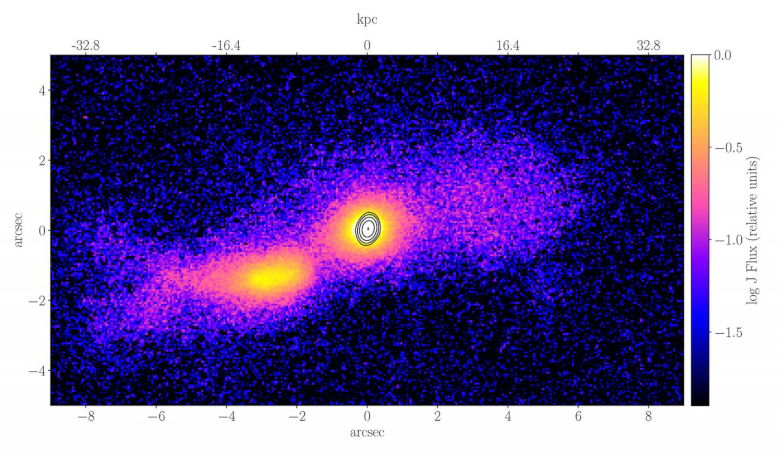A team of Clemson University College of Science researchers, in collaboration with international colleagues, has reported the first definitive detection of a relativistic jet emerging from two colliding galaxies – in essence, the first photographic proof that merging galaxies can produce jets of charged particles that travel at nearly the speed of light.
Furthermore, scientists had previously discovered that these jets could be found in elliptical-shaped galaxies, which can be formed in the merging of two spiral galaxies. Now, they have an image showing the formation of a jet from two younger, spiral-shaped galaxies.
"For the first time, we have found two spiral- or disk-shaped galaxies on path for a collision that have produced a nascent, baby jet that has just started its life at the center of one of the galaxies," said Vaidehi Paliya, a former Clemson post-doctoral researcher and lead author of the findings reported in the Astrophysical Journal on April 7, 2020.
The paper is titled "TXS 2116-077: A gamma-ray emitting relativistic jet hosted in a galaxy merger." In addition to Paliya, who is now at the Deutsches Elektronen Synchrotron (DESY) in Germany, the other Clemson authors include associate professor Marco Ajello, professor Dieter Hartmann, and adjunct professor Stefano Marchesi of the department of physics and astronomy.
The fact that the jet is so young enabled the researchers to clearly see its host.
According to Ajello, others have already imaged galactic collisions many times. But he and his colleagues are the first to capture two galaxies merging where there is a fully formed jet pointing at us -- albeit, a very young one, and thus not yet bright enough to blind us.
"Typically, a jet emits light that is so powerful we can't see the galaxy behind it," Marchesi said. "It's like trying to look at an object and someone points a bright flashlight into your eyes. All you can see is the flashlight. This jet is less powerful, so we can actually see the galaxy where it is born."
Jets are the most powerful astrophysical phenomena in the universe. They can emit more energy into the universe in one second than our sun will produce in its entire lifetime. That energy is in the form of radiation, such as intense radio waves, X-rays, and gamma-rays.
"Jets are the best accelerators in the universe -- far better than the super colliders we have on Earth," said Hartmann, referring to accelerators used in high-energy physics studies.
Jets were thought to be born from older, elliptical-shaped galaxies with an active galactic nucleus (AGN), which is a super-massive black hole that resides at its center. As a point of reference, scientists believe all galaxies have centrally located super-massive black holes, but not all of them are AGNs. For example, our Milky Way's massive black hole is dormant.
Scientists theorize that the AGNs grow larger by gravitationally drawing in gas and dust through a process called accretion. But not all of this matter gets accreted into the black hole. Some of the particles become accelerated and are spewed outward in narrow beams in the form of jets.
"It's hard to dislodge gas from the galaxy and have it reach its center," Ajello explained. "You need something to shake the galaxy a little bit to make the gas get there. The merging or colliding of galaxies is the easiest way to move the gas, and if enough gas moves, then the super-massive black hole will become extremely bright and could potentially develop a jet."
Ajello believes that the team's image captured the two galaxies, a Seyfert 1 galaxy known as TXS 2116-077 and another galaxy of similar mass, as they were colliding for the second time because of the amount of gas seen in the image.
"Eventually, all the gas will be expelled into space, and without gas, a galaxy cannot form stars anymore," Ajello said. "Without gas, the black hole will switch off and the galaxy will lay dormant."
Billions of years from now, our own Milky Way will merge with the nearby Andromeda galaxy.
"Scientists have carried out detailed numerical simulations and predicted that this event may ultimately lead to the formation of one giant elliptical galaxy," said Paliya. "Depending on the physical conditions, it may host a relativistic jet, but that's in the distant future."
The team captured the image using one of the largest land-based telescopes in the world, the Subaru 8.2-meter optical infrared telescope located on a mountain summit in Hawaii. They performed subsequent observations with the Gran Telescopio Canarias and William Herschel Telescope on the island of La Palma off the coast of Spain, as well as with NASA's Chandra X-Ray Observatory space telescope.











